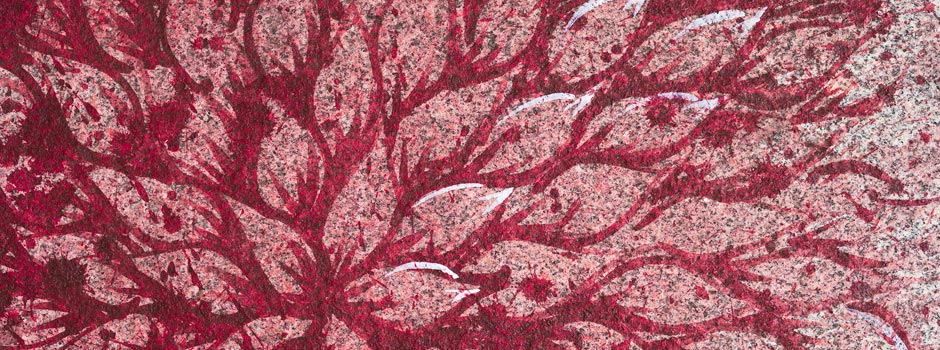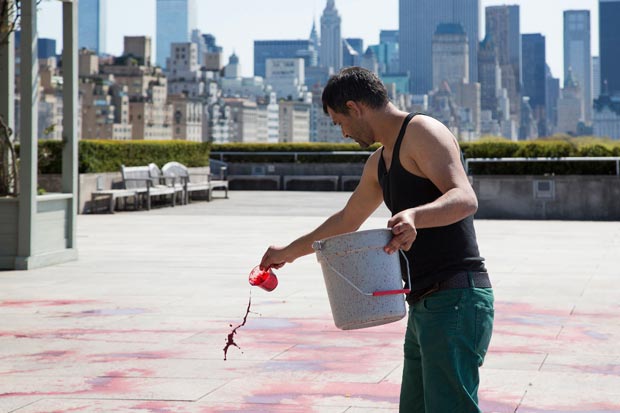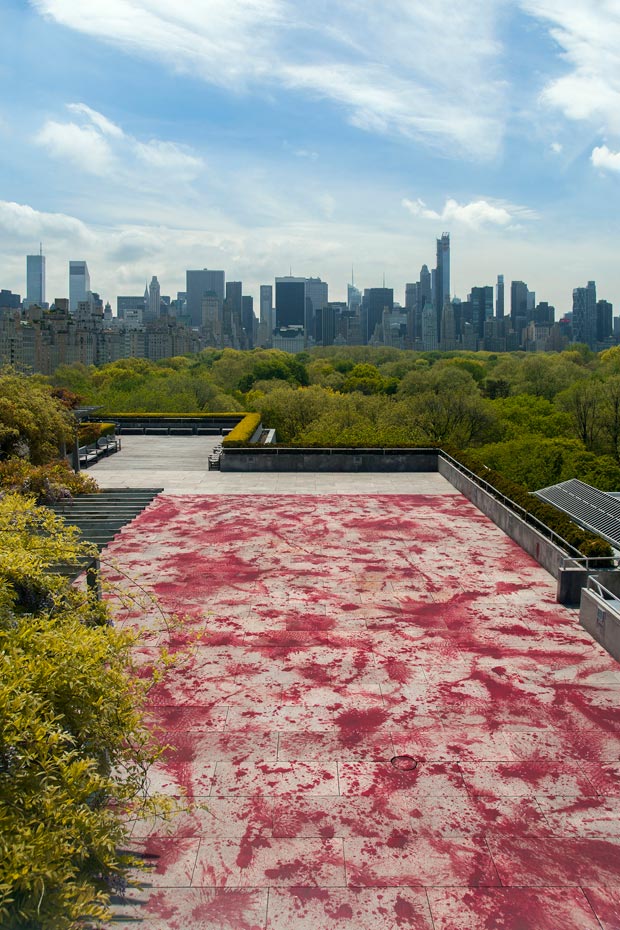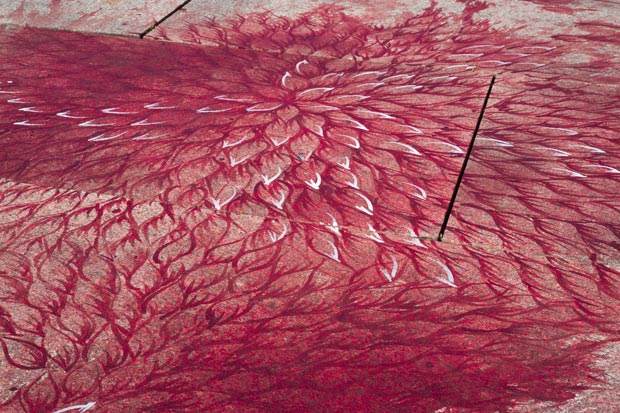
Roof Garden Installation by Imran Qureshi at Metropolitan Museum
May 17, 2013 Exhibition
 Imran Qureshi creating his site-specific work And How Many Rains Must Fall before the Stains Are Washed Clean for The Roof Garden Commission project on The Metropolitan Museum of Art’s Iris and B. Gerald Cantor Roof Garden / Photograph: The Metropolitan Museum of Art/Hyla Skopitz
Imran Qureshi creating his site-specific work And How Many Rains Must Fall before the Stains Are Washed Clean for The Roof Garden Commission project on The Metropolitan Museum of Art’s Iris and B. Gerald Cantor Roof Garden / Photograph: The Metropolitan Museum of Art/Hyla Skopitz
Entitled The Roof Garden Commission: Imran Qureshi, the project represents the artist’s emotional response to violence occurring across the globe in recent decades and his earnest hope for regeneration and lasting peace in the aftermath of man-made disasters. Using the nearly 8,000-square-foot open-air space as his canvas, Qureshi has worked areas of his spilled and splattered red acrylic paint into patterns of lush ornamental leaves that evoke the luxuriant walled gardens that are ubiquitous in miniatures of the Mughal court; they also echo the spectacular verdant foliage of Central Park surrounding the Roof Garden today. Qureshi is the first artist that created a work that was painted directly onto the Roof’s surface. The visitors are encouraged to walk on it as they view it.
 Installation View: And How Many Rains Must Fall before the Stains Are Washed Clean (2013), By Imran Qureshi (b. 1972, Hyderabad, Pakistan), The Roof Garden Commission: Imran Qureshi / Photograph: The Metropolitan Museum of Art/Hyla Skopitz
Installation View: And How Many Rains Must Fall before the Stains Are Washed Clean (2013), By Imran Qureshi (b. 1972, Hyderabad, Pakistan), The Roof Garden Commission: Imran Qureshi / Photograph: The Metropolitan Museum of Art/Hyla Skopitz
_620_Roof_Garden_Installation_by_Imran_Qureshi_at_Metropolitan_Museum.jpg) Installation View/detail: And How Many Rains Must Fall before the Stains Are Washed Clean (2013), By Imran Qureshi (b. 1972, Hyderabad, Pakistan), The Roof Garden Commission: Imran Qureshi / Photograph: The Metropolitan Museum of Art/Hyla Skopitz
Installation View/detail: And How Many Rains Must Fall before the Stains Are Washed Clean (2013), By Imran Qureshi (b. 1972, Hyderabad, Pakistan), The Roof Garden Commission: Imran Qureshi / Photograph: The Metropolitan Museum of Art/Hyla Skopitz
“We are proud to present this extraordinary new commission,†stated Thomas P. Campbell, Director and CEO of the Metropolitan Museum. “For years, Imran Qureshi has created emotionally wrought, thought-provoking installations devoted to themes of tragedy and regeneration, reflecting conditions that prevail almost as a way of life in his home country—and that now, sadly, also resonate in the wake of the recent Boston Marathon tragedy. The installation’s presence on the Roof Garden this summer creates an especially timely and evocative commentary on these devastating events, and encourages us to respond thoughtfully both as individuals and as citizens of a shared community.â€
“We are honored that Imran Qureshi has brought his spirit, sensitivity, and remarkable vision to the Metropolitan Museum this summer,†said Sheena Wagstaff, the Museum’s Leonard A. Lauder Chairman of Modern and Contemporary Art. “His artistic practice oscillates between the discipline and reinvention of the miniature format, and the expansive scale of architectural spaces. His works are wonderfully complex at the same time as appearing quite simple: they reckon with the unfortunate realities of political ideologies while reveling in the ability of paint and color to depict and actively stimulate regeneration.â€
Imran Qureshi said, “The dialogue between life and death is an important element in my work. Leaves and nature, for example, represent the idea of life. And the particular color of red that I have been using in recent years can look so real, like blood. The red reminds me of the situation today in my country, Pakistan, and in the world around us, where violence is almost a daily occurrence. But somehow, people still have hope. The flowers that seem to emerge from the red paint in my work represent the hope that—despite everything—the people sustain somehow, their hope for a better future.â€
 Installation View/detail: And How Many Rains Must Fall before the Stains Are Washed Clean (2013). By Imran Qureshi (b. 1972, Hyderabad, Pakistan). The Roof Garden Commission: Imran Qureshi / Photograph: The Metropolitan Museum of Art/Hyla Skopitz
Installation View/detail: And How Many Rains Must Fall before the Stains Are Washed Clean (2013). By Imran Qureshi (b. 1972, Hyderabad, Pakistan). The Roof Garden Commission: Imran Qureshi / Photograph: The Metropolitan Museum of Art/Hyla Skopitz
 Installation View/detail: And How Many Rains Must Fall before the Stains Are Washed Clean (2013). By Imran Qureshi (b. 1972, Hyderabad, Pakistan). The Roof Garden Commission: Imran Qureshi / Photograph: The Metropolitan Museum of Art/Hyla Skopitz
Installation View/detail: And How Many Rains Must Fall before the Stains Are Washed Clean (2013). By Imran Qureshi (b. 1972, Hyderabad, Pakistan). The Roof Garden Commission: Imran Qureshi / Photograph: The Metropolitan Museum of Art/Hyla Skopitz
Born in Hyderabad, Pakistan, in 1972, Imran Qureshi is considered one of the leading figures in developing a contemporary aesthetic that integrates the motifs and rigorous techniques of traditional miniature painting, which flourished in the Mughal courts of the Indian subcontinent at the end of the 16th century, with contemporary themes. Qureshi received his B.A. in Fine Art in 1993 from the National College of Arts in Lahore, where as assistant professor he now teaches new generations of artists. He was named Deutsche Bank’s “Artist of the Year†for 2013 and inaugurated the Deutsche Bank KunstHalle in Berlin last month with a major solo exhibition. He won the 2011 Sharjah Biennial Prize for his installation Blessings Upon the Land of my Love. Qureshi was also one of 15 Pakistani artists featured in the Asia Society exhibition Hanging Fire: Contemporary Art from Pakistan (2009-2010). Solo exhibitions of his work have been held at the Rohtas Gallery in Lahore (2010), Chawkandi Art in Karachi (2010), Corvi-Mora Gallery in London (2007), Canvas Gallery in Karachi (2007), Modern Art Oxford (2007), and Lalit Kala Akademi in New Delhi (2006). His work was also featured at the Singapore Biennale in 2006 and the Sydney Biennale in 2012. The artist lives and works in Lahore.
The exhibition is made possible by Bloomberg. Additional support is provided by Cynthia Hazen Polsky and Leon B. Polsky.
Comments
Add a comment